Fluid Migration through Permafrost and the Pool of Greenhouse Gases in Frozen Soils of an Oil and Gas Field
Abstract
:1. Introduction
2. Materials and Methods
2.1. Study Area
- The Bakhta terrace (55–70 m a.s.l.), composed of marine and glacial-marine loams, loamy sands, and sands with pebble and gravel of Middle Pleistocene age (230–129 kyr).
- The Kazantsevo plain (55–60 m a.s.l.), represented by marine sands, loams, and loamy sands of Upper Pleistocene age (129–80 kyr).
- Alases (lacustrine and bog depressions formed by thermokarst) of Holocene age (younger than 11.7 kyr), forming gently sloping (slope classification according to [41]) plains (50–60 m a.s.l.), dominated by peats, silts, and loamy sands. Thermokarst lakes were mostly drained by shallow streams and converted to wetlands, but those remaining have depths of 2–5 m.
- Floodplains and terraces of rivers and gullies (40–50 m a.s.l.), composed of alluvial sands, diluvium, and proluvium of Holocene age.
- i.
- Inequigranular sands, clays with the lenses of gravels, and interbeds of kaolinite of the Korliki formation of Upper Eocene-Oligocene age (37.8–23.03 Myr);
- ii.
- Clays and silts with interbeds of quartz-glauconite kaolinized sands, inclusions of gravels, and siderite concretions of the Yurki formation of Upper Eocene age (37.8–33.9 Myr);
- iii.
- Poorly defined diatomaceous earth and clays with interbeds of glauconite sands of the Irbit formation of Middle-Upper Eocene age (41.2–33.9 Myr);
- iv.
- Silica clays with interbeds of diatomaceous clays of the Serov formation of Lower Eocene age (56.0–47.8 Myr);
- v.
- Poorly defined silty clays with interbeds of sands and lenses of lignite of the Tibey-Sale formation of Paleocene age (66.0–56.0 Myr).
2.2. Studies of Gas Composition in Frozen Soils
- C2+ C3 (the sum of C2H6 and C3H8, vol.%);
- C2/C3ratio (vol.% of C2H6 divided by C3H8) indicating leakage from either a gas or oil bed;
- C1/C2–3ratio (vol.% of CH4 divided by C2 + C3), indicating the cathagenetic (produced at high temperature from deeply metamorphosed organic matter in the rocks) or biogenic (produced microbially from organic compounds under surface conditions) origin of the gas mixture. C1/C2–3 ratio is above 1000 when the gas is biogenic, and is below 100 when it has migrated from a hydrocarbon reservoir [53].
- A Chrom-5 (Laboratory Instruments, Prague, Czech Republic), equipped with a 3 mm × 3 m column filled with aluminum oxide, using helium as a carrier gas, and a flame-ionizing detector, with a quantification limit of 1 ppm;
- A Kristall-5000.2 (Chromatek, Yoshkar-Ola, Russia), equipped with a 0.25 mm × 100 m column filled with polydimethylsiloxane, using helium as a carrier gas, and a flame-ionizing detector, with a quantification limit of 0.4 ppm.
2.3. Studies of Subsurface Structure Using Geophysical Sounding
- The topmost 100–180 m had a resistivity up to 2000–3000 Ω m, associated with ice-bearing permafrost with ice content of 10–50% and a temperature from −2 to −5 °C;
- The 20 m thick layer below the permafrost had a resistivity of 5–10 Ω∙m which correlated to the thawed sands of an intrapermafrost talik;
- Down to depths of 350–400 m below the surface, there was a layer with a resistivity of 10–50 Ω∙m corresponding to cryotic (sediments at subzero temperature without ice) or thawed deposits.
2.4. GIS and Remote Sensing Studies
2.4.1. Terrain and Geological Data
2.4.2. Lineament Analysis
2.4.3. Land Cover
2.5. Geostatistics
3. Results
3.1. Variability of GHGs and Other Gases in Frozen Soils
3.2. Thickness of Permafrost and Faults Reaching the Surface
3.3. Surface Factors of the GHG Concentrations in Soils
4. Discussion
4.1. Geological Sources
4.1.1. The Effect of Tectonics on Fluid Shows in Soils
4.1.2. Microseeps
4.1.3. Diffuse Flow
4.2. Contribution of Geological and Surface Factors to Concentration of GHGs in Frozen Soil
5. Conclusions
Author Contributions
Funding
Acknowledgments
Conflicts of Interest
Appendix A. Variables Used in the Geodatabase and Statistical Analysis
| Variable | Description | Normalization Function |
|---|---|---|
| Site ID | Field number of the sampling site | |
| Concentrations of gases in frozen soils | ||
| CH4 | Concentration of methane in frozen soil at 0.6–0.7 m depth, mg m−3 | =CH4−0.1236 |
| C2H6 | Concentration of ethane in frozen soil at 0.6–0.7 m depth, mg m−3 | =C2H60.14 |
| C3H8 | Concentration of propane in frozen soil at 0.6–0.7 m depth, mg m−3 | =C3H80.13 |
| C2 + C3 | Sum of concentrations of ethane and propane in frozen soil at 0.6–0.7 m depth, vol.% | |
| C1/C2–3 ratio | Ratio of volumetric concentration of gases in frozen soil at 0.6–0.7 m depth, measured in vol.%, units | |
| C2/C3 | Ratio of volumetric concentrations of ethane to propane in frozen soil at 0.6–0.7 m depth, measured in vol.%, units | |
| CO2 | Concentration of carbon dioxide in frozen soil at 0.6–0.7 m depth, mg m−3 | =CO20.3 |
| O2 | Concentration of oxygen in frozen soil at 0.6–0.7 m depth, mg m−3 | =O20.5 |
| H2 | Concentration of hydrogen in frozen soil at 0.6–0.7 m depth, mg m−3 | =H20.25 |
| He | Concentration of helium in frozen soil at 0.6–0.7 m depth, mg m−3 | |
| Surface factors | ||
| Lat. | Latitude, ° N | |
| Lon. | Longitude, ° E | |
| Soil | Soil class based on grain size and organic matter content based on Russian classification [69] | |
| Alt. | Altitude, based on DEM, m | =alt2 |
| Slope | Slope, based on DEM, ° | =slope0.11 |
| Slope class | Slope class, following the Food and Agriculture Organization [41] classification | |
| Aspect | Vector of a slope, ° | =aspect0.5 |
| Orientation | Direction which slopes face, the classes of aspect, based on the 16-wind compass rose | |
| Land cover type no. | Code of land cover type following A. Bartsch et al. [48] classification (Table A2) | |
| Land cover type name | Class name of the land cover type following A. Bartsch et al. [48] classification (Table A2) | |
| Domain | Group of the land cover types following A. Bartsch et al. [48] classification (Table A2) | |
| Wetness | Dry, moist, wet, or waterlogged land classes following A. Bartsch et al. [48] classification (Table A2) | |
| Geological factors | ||
| Terrain | Surface morphological feature characterized by the altitude and the type and age of sediments composing it, based on DEM data and geological map [42] | |
| Lineament buffer | Distance to the nearest lineament from the sampling site, three categories corresponding to lineaments detected at different scales: 1:30,000 scale—30 m buffer distance; 1:100,000 scale—100 m buffer distance; 1:200,000 scale—200 m buffer distance; and a category of NOT APPLICABLE for all others | |
| Faults density | Length of the gradient zones reaching the surface using an electric survey in a circular neighborhood with a diameter of 450 m around the sampling site, km·km−2 | |
| Lineaments density | Length of lineaments in a circular neighborhood with a diameter of 450 m around the sampling site, km·km−2 | |
| Permafrost thickness | Thickness of the topmost interval with the electric resistivity corresponding to various ice-containing sediments, m | |
| Data Code (No.) | Class Name | Group | Wetness |
|---|---|---|---|
| 1 | Sparse vegetation (without shrubs), mostly sandy soil; flood plains, recent landslides, also within fire scars | Sparse vegetation | No data |
| 2 | Dry cryptogamic-crust or sparse vegetation | Sparse vegetation | Dry |
| 3 | Graminoid, prostrate dwarf shrub, patterned ground, partially bare | Shrub tundra | No data |
| 4 | Dry to moist prostrate to erect dwarf shrub tundra | Shrub tundra | Dry to moist |
| 5 | Moist to wet graminoid prostrate to erect dwarf shrub tundra | Shrub tundra | Moist to wet |
| 6 | Wet to waterlogged graminoid prostrate to low shrub tundra | Shrub tundra | Wet to waterlogged |
| 7 | Moist low-density shrubs | Shrub tundra | Moist |
| 8 | Tall shrubs, deciduous forest | Forest | No data |
| 9 | Mixed forest | Forest | No data |
| 10 | Coniferous (partially mixed) forest | Forest | No data |
| 11 | Meadows, grass and herb-dominated | Grassland | No data |
| 12 | Wet ecotops, especially in floodplains | Floodplain | Wet |
| 13 | Disturbed: seasonally inundated areas and landslide scars | Disturbed | No data |
| 14 | Floodplain, mostly fluvial | Floodplain | No data |
| 15 | Floodplain, mostly lacustrine | Floodplain | No data |
| 16 | Seasonally inundated | Floodplain | No data |
| 17 | Barren, rare vegetation (petrophytes and psammophytes) | Barren | No data |
| 18 | Barren, including artificial surfaces | Barren | No data |
| 19 | Water (shallow or high sediment yield) | Water | Waterlogged |
| 20 | Water (medium depth or medium sediment yield) | Water | Waterlogged |
| 21 | Water (low sediment yield) | Water | Waterlogged |
References
- McGuire, A.D.; Anderson, L.G.; Christensen, T.R.; Dallimore, S.; Guo, L.; Hayes, D.J.; Heimann, M.; Lorenson, T.D.; Macdonald, R.W.; Roulet, N. Sensitivity of the carbon cycle in the Arctic to climate change. Ecol. Monogr. 2009, 79, 523–555. [Google Scholar] [CrossRef] [Green Version]
- Björkman, M.P.; Morgner, E.; Cooper, E.J.; Elberling, B.; Klemedtsson, L.; Björk, R.G. Winter carbon dioxide effluxes from Arctic ecosystems: An overview and comparison of methodologies. Glob. Biogeochem. Cycles 2010, 24. [Google Scholar] [CrossRef]
- Mastepanov, M.; Sigsgaard, C.; Tagesson, T.; Ström, L.; Tamstorf, M.P.; Lund, M.; Christensen, T.R. Revisiting factors controlling methane emissions from high-Arctic tundra. Biogeosciences 2013, 10, 5139–5158. [Google Scholar] [CrossRef] [Green Version]
- Karelin, D.; Goryachkin, S.; Zazovskaya, E.; Shishkov, V.; Pochikalov, A.; Dolgikh, A.; Sirin, A.; Suvorov, G.; Badmaev, N.; Badmaeva, N.; et al. Greenhouse gas emission from the cold soils of Eurasia in natural settings and under human impact: Controls on spatial variability. Geoderma Reg. 2020, 22, e00290. [Google Scholar] [CrossRef]
- Mörner, N.-A.; Etiope, G. Carbon degassing from the lithosphere. Glob. Planet. Chang. 2002, 33, 185–203. [Google Scholar] [CrossRef]
- Etiope, G. Natural Gas. Seepage. The Earth’s Hydrocarbon Degassing; Springer: Cham, Germany, 2015; p. 199. [Google Scholar]
- Van Everdingen, R.O. Multi-Language Glossary of Permafrost and Related Ground-Ice Terms in Chinese, English, French, German, Icelandic, Italian, Norwegian, Polish, Romanian, Russian, Spanish, and Swedish; International Permafrost Association: Calgary, AB, Canada, 2005; p. 159. [Google Scholar]
- Gleeson, T.; Smith, L.; Moosdorf, N.; Hartmann, J.; Dürr, H.H.; Manning, A.H.; van Beek, L.P.H.; Jellinek, A.M. Mapping permeability over the surface of the Earth. Geophys. Res. Lett. 2011, 38, L02401. [Google Scholar] [CrossRef] [Green Version]
- Etiope, G.; Ciotoli, G.; Schwietzke, S.; Schoell, M. Gridded maps of geological methane emissions and their isotopic signature. Earth Syst. Sci. Data 2019, 11, 1–22. [Google Scholar] [CrossRef] [Green Version]
- Ciais, P.; Sabine, C.; Bala, G.; Bopp, L.; Brovkin, V.; Canadell, J.; Chhabra, A.; DeFries, R.; Galloway, J.; Heimann, M.; et al. Carbon and other biogeochemical cycles. In Climate Change 2013: The Physical Science Basis. Contribution of Working Group I to the Fifth Assessment Report of the Intergovernmental Panel on Climate Change; Stocker, T.F., Qin, D., Plattner, G.-K., Tignor, M., Allen, S.K., Boschung, J., Nauels, A., Xia, Y., Bex, V., Midgley, P.M., Eds.; Cambridge University Press: Cambridge, NY, USA, 2013; pp. 465–570. [Google Scholar]
- Heede, R.; Oreskes, N. Potential emissions of CO2 and methane from proved reserves of fossil fuels: An alternative analysis. Glob. Environ. Chang. 2016, 36, 12–20. [Google Scholar] [CrossRef] [Green Version]
- Chuvilin, E.M.; Grebenkin, S.I.; Sacleux, M. Influence of moisture content on permeability of frozen and unfrozen soils. Kriosf. Zemli 2016, 20, 66–72. [Google Scholar]
- Are, F.E. The problem of the emission of deep-buried gases to the atmosphere. In Permafrost Response on Economic Development, Environmental security and Natural Resources; Paepe, R., Melnikov, V.P., Van Overloop, E., Gorokhov, V.D., Eds.; Springer: Dordrecht, The Netherlands, 2001; pp. 497–509. [Google Scholar] [CrossRef]
- Etiope, G. Subsoil CO2 and CH4 and their advective transfer from faulted grassland to the atmosphere. J. Geophys. Res. Atmos. 1999, 104, 16889–16894. [Google Scholar] [CrossRef]
- Velikotskii, M.A. Morfologiya alasnogo rel’efa i neotektonika severnoi chasti Yano-Omoloiskogo mezhdurech’ya (Alas relief morphology and neotectonics of the Yana-Omoloy interfluve northern part). Vestnik Mosk. Univ. Seriya 5 Geogr. 1972, 2, 101–104. [Google Scholar]
- Bowen, R.G.; Dallimore, S.R.; Côté, M.M.; Wright, J.F.; Lorenson, T.D. Geomorphology and gas release from pockmark features in the Mackenzie delta, Northwest Territories, Canada. In Proceedings of the Ninth International Conference on Permafrost, Fairbanks, AK, USA, 29 June–3 July 2008; pp. 171–176. [Google Scholar]
- Walter Anthony, K.M.; Anthony, P.; Grosse, G.; Chanton, J. Geologic methane seeps along boundaries of Arctic permafrost thaw and melting glaciers. Nat. Geosci. 2012, 5, 419–426. [Google Scholar] [CrossRef]
- Kohnert, K.; Serafimovich, A.; Metzger, S.; Hartmann, J.; Sachs, T. Strong geologic methane emissions from discontinuous terrestrial permafrost in the Mackenzie Delta, Canada. Sci. Rep. 2017, 7, 5828. [Google Scholar] [CrossRef] [Green Version]
- Anisimov, O.A.; Zaboikina, Y.G.; Kokorev, V.A.; Yurganov, L.N. Vozmozhnye prichiny emissii metana na shel’fe morei Vostochnoi Arktiki (Possible causes of methane release from the East Arctic seas shelf). Led I Sneg 2014, 54, 69–81. [Google Scholar] [CrossRef]
- Tanner, D.C.; Buness, H.; Igel, J.; Günther, T.; Gabriel, G.; Skiba, P.; Plenefisch, T.; Gestermann, N.; Walter, T.R. Fault detection. In Understanding Faults; Tanner, D., Brandes, C., Eds.; Elsevier: Cambridge, NY, USA, 2020; pp. 81–146. [Google Scholar]
- Rivkina, E.; Gilichinsky, D.; Wagener, S.; Tiedje, J.; McGrath, J. Biogeochemical activity of anaerobic microorganisms from buried permafrost sediments. Geomicrobiol. J. 1998, 15, 187–193. [Google Scholar] [CrossRef]
- Badu, Y.B. Foundations of the conception of subaqual cryolithogenesis of marine deposits of gas-bearing structures on the Yamal Peninsula. Kriosf. Zemli 2017, 21, 65–72. [Google Scholar] [CrossRef]
- Kraev, G.; Rivkina, E.; Vishnivetskaya, T.; Belonosov, A.; van Huissteden, J.; Kholodov, A.; Smirnov, A.; Kudryavtsev, A.; Teshebaeva, K.; Zamolodchikov, D. Methane in gas shows from boreholes in epigenetic permafrost of Siberian Arctic. Geosciences 2019, 9, 67. [Google Scholar] [CrossRef] [Green Version]
- Singhroha, S.; Bünz, S.; Plaza-Faverola, A.; Chand, S. Detection of gas hydrates in faults using azimuthal seismic velocity analysis, Vestnesa Ridge, W-Svalbard margin. J. Geophys. Res. Solid Earth 2020, 125, e2019JB017949. [Google Scholar] [CrossRef]
- Tedesco, S.A. Surface Geochemistry in Petroleum Exploration, 1st ed.; Springer Science + Business Media: Dordrecht, The Netherlands, 1995; p. 206. [Google Scholar]
- Karelin, D.V.; Zamolodchikov, D.G. Uglerodnyi Obmen v Kriogennykh Ekosistemakh (Carbon Exchange of Cryogenic Ecosystems); Nauka: Moscow, Russia, 2008; p. 342. [Google Scholar]
- Lupascu, M.; Czimczik, C.I.; Welker, M.C.; Ziolkowski, L.A.; Cooper, E.J.; Welker, J.M. Winter ecosystem respiration and sources of CO2 from the high Arctic tundra of Svalbard: Response to a deeper snow experiment. J. Geophys. Res. Biogeosci. 2018, 123, 2627–2642. [Google Scholar] [CrossRef]
- Oechel, W.C.; Vourlitis, G.; Hastings, S.J. Cold season CO2 emission from Arctic soils. Glob. Biogeochem. Cycles 1997, 11, 163–172. [Google Scholar] [CrossRef]
- Elberling, B.; Brandt, K.K. Uncoupling of microbial CO2 production and release in frozen soil and its implications for field studies of arctic C cycling. Soil Biol. Biochem. 2003, 35, 263–272. [Google Scholar] [CrossRef]
- Schaefer, K.; Jafarov, E. A parameterization of respiration in frozen soils based on substrate availability. Biogeosciences 2016, 13, 1991–2001. [Google Scholar] [CrossRef] [Green Version]
- Zimov, S.A.; Zimova, G.M.; Daviodov, S.P.; Daviodova, A.I.; Voropaev, Y.V.; Voropaeva, Z.V.; Prosiannikov, S.F.; Prosiannikova, O.V.; Semiletova, I.V.; Semiletov, I.P. Winter biotic activity and production of CO2 in Siberian soils: A factor in the greenhouse effect. J. Geophys. Res. Atmos. 1993, 98, 5017–5023. [Google Scholar] [CrossRef]
- Rivkina, E.M.; Laurinavichus, K.S.; Gilichinsky, D.A.; Shcherbakova, V.A. Methane generation in permafrost sediments. Dokl. Biol. Sci. 2002, 383, 179–181. [Google Scholar] [CrossRef] [PubMed]
- Tagesson, T.; Mölder, M.; Mastepanov, M.; Sigsgaard, C.; Tamstorf, M.P.; Lund, M.; Falk, J.M.; Lindroth, A.; Christensen, T.R.; Ström, L. Land-atmosphere exchange of methane from soil thawing to soil freezing in a high-Arctic wet tundra ecosystem. Glob. Chang. Biol. 2012, 18, 1928–1940. [Google Scholar] [CrossRef] [Green Version]
- Treat, C.C.; Bloom, A.A.; Marushchak, M.E. Nongrowing season methane emissions—A significant component of annual emissions across northern ecosystems. Glob. Chang. Biol. 2018, 24, 3331–3343. [Google Scholar] [CrossRef] [PubMed] [Green Version]
- Zona, D.; Gioli, B.; Commane, R.; Lindaas, J.; Wofsy, S.C.; Miller, C.E.; Dinardo, S.J.; Dengel, S.; Sweeney, C.; Karion, A.; et al. Cold season emissions dominate the Arctic tundra methane budget. Proc. Natl. Acad. Sci. USA 2016, 113, 40–45. [Google Scholar] [CrossRef] [PubMed] [Green Version]
- Webb, E.E.; Schuur, E.A.G.; Natali, S.M.; Oken, K.L.; Bracho, R.; Krapek, J.P.; Risk, D.; Nickerson, N.R. Increased wintertime CO2 loss as a result of sustained tundra warming. J. Geophys. Res. Biogeosci. 2016, 121, 249–265. [Google Scholar] [CrossRef] [Green Version]
- Natali, S.M.; Watts, J.D.; Rogers, B.M.; Potter, S.; Ludwig, S.M.; Selbmann, A.-K.; Sullivan, P.F.; Abbott, B.W.; Arndt, K.A.; Birch, L.; et al. Large loss of CO2 in winter observed across the northern permafrost region. Nat. Clim. Chang. 2019, 9, 852–857. [Google Scholar] [CrossRef]
- Pirk, N.; Santos, T.; Gustafson, C.; Johansson, A.J.; Tufvesson, F.; Parmentier, F.-J.W.; Mastepanov, M.; Christensen, T.R. Methane emission bursts from permafrost environments during autumn freeze-in: New insights from ground-penetrating radar. Geophys. Res. Lett. 2015, 42, 6732–6738. [Google Scholar] [CrossRef]
- Arndt, K.A.; Oechel, W.C.; Goodrich, J.P.; Bailey, B.A.; Kalhori, A.; Hashemi, J.; Sweeney, C.; Zona, D. Sensitivity of methane emissions to later soil freezing in Arctic tundra ecosystems. J. Geophys. Res. Biogeosci. 2019, 124, 2595–2609. [Google Scholar] [CrossRef]
- Obu, J.; Westermann, S.; Bartsch, A.; Berdnikov, N.; Christiansen, H.H.; Dashtseren, A.; Delaloye, R.; Elberling, B.; Etzelmüller, B.; Kholodov, A.; et al. Northern Hemisphere permafrost map based on TTOP modelling for 2000–2016 at 1 km2 scale. Earth Sci. Rev. 2019, 193, 299–316. [Google Scholar] [CrossRef]
- Jahn, R.; Blume, H.-P.; Asio, V.B.; Spaargaren, O.; Schad, P.; Langohr, R.; Brinkman, R.; Nachtergaele, F.O.; Krasilnikov, R.P. Guidelines for Soil Description, 4th ed.; Food and Agriculture Organization of the United Nations: Rome, Italy, 2006; p. 97. [Google Scholar]
- Astapov, A.P.; Gubanova, T.P.; Faibusovich, Y.E. Gosudarstvennaya Geologicheskaya Karta Rossiiskoi Federatsii Masshtaba 1:200,000. Seriya Zapadno-Sibirskaya. Listy Q-43-IX, X, XIII-XVIII, XXI, XXII (1:200,000 State Geological Map of the Russian Federation. West-Siberian Series. Plates Q-43-IX, X, XIII-XVIII, XXI, XXII); Nedra: Moscow, Russia, 1995. [Google Scholar]
- Sukhov, A.G.; Kuznetsova, I.L.; Lakhtina, O.V.; Drozdov, D.S.; Chekrygina, S.N. Tazovskaya oblast’ (Taz region). In Geokriologiya SSSR. Zapadnaya Sibir’ (Geocryology of the USSR. The West Siberia); Ershov, E.D., Ed.; Nedra: Moscow, Russia, 1989; pp. 236–247. [Google Scholar]
- Trofimov, V.T.; Mel’nitskii, E.V.; Neizvestnov, Y.V. Osobennosti formirovaniya i stroeniya geologo-geneticheskikh kompleksov otlozhenii i razvitiya rel’efa Zapadno-Sibirskoi plity v golotsene (Origins and structure of geological and genetic sedimentary complexes and evolution of the landscape of West-Siberian plate in Holocene) In Geokriologiya SSSR. Zapadnaya Sibir’ (Geocryology of the USSR. The West Siberia); Ershov, E.D., Ed.; Nedra: Moscow, Russia, 1989; pp. 88–96. [Google Scholar]
- Brown, J.; Ferrians Jr., O.J.; Heginbottom, J.A.; Melnikov, E.S. Circum-Arctic Map of Permafrost and Ground-Ice Conditions 1:10,000,000; U.S. Geological Survey: Denver, CO, USA, 1997. [Google Scholar]
- Beck, H.E.; Zimmermann, N.E.; McVicar, T.R.; Vergopolan, N.; Berg, A.; Wood, E.F. Present and future Köppen-Geiger climate classification maps at 1-km resolution. Sci. Data 2018, 5, 180214. [Google Scholar] [CrossRef] [PubMed] [Green Version]
- Udalennyi dostup k YaOD-arkhivam (Remote Access to Archives of the Hydrometheorological Data Descriptors). Available online: http://aisori-m.meteo.ru/waisori/ (accessed on 1 October 2020).
- Bartsch, A.; Widhalm, B.; Pointner, G.; Ermokhina, K.; Leibman, M.; Heim, B. Landcover Derived from Sentinel-1 and Sentinel-2 Satellite Data (2015–2018) for Subarctic and Arctic Environments; Zentralanstalt für Meteorologie und Geodynamik: Wien, Austria, 2019. [Google Scholar] [CrossRef]
- Jones, M.H.; Fahnestock, J.T.; Welker, J.M. Early and Late Winter CO2 Efflux from Arctic Tundra in the Kuparuk River Watershed, Alaska, USA. Arctic Antarct. Alpine Res. 1999, 31, 187–190. [Google Scholar] [CrossRef]
- Yi-Yan, N.; Felder, R.M.; Koros, W.J. Selective permeation of hydrocarbon gases in poly(tetrafluoroethylene) and poly(fluoroethylene–propylene) copolymer. J. Appl. Polym. Sci. 1980, 25, 1755–1774. [Google Scholar] [CrossRef]
- Yoro, S.C.; Panagiotopoulos, C.; Sempéré, R. Dissolved organic carbon contamination induced by filters and storage bottles. Water Res. 1999, 33, 1956–1959. [Google Scholar] [CrossRef]
- Green, J.D. Headspace Analysis: Static. In Encyclopedia of Analytical Science, 2nd ed.; Worsfold, P., Townshend, A., Poole, C., Eds.; Elsevier: Oxford, UK, 2005; pp. 229–236. [Google Scholar]
- Bernard, B.B.; Brooks, J.M.; Sackett, W.M. Natural gas seepage in the Gulf of Mexico. Earth Planet. Sci. Lett. 1976, 31, 48–54. [Google Scholar] [CrossRef]
- Nabighian, M.N.; Macnae, J.C. Time domain electromagnetic prospecting methods. In Electromagnetic Methods in Applied Geophysics; Nabighian, M.N., Ed.; Society of Exploration Geophysicists: Tulsa, OK, USA, 1991; Volume 2, pp. 427–520. [Google Scholar]
- Reynolds, J.M. An Introduction to Applied and Environmental Geophysics, 2nd ed.; John Wiley & Sons, Ltd.: Chichester, UK, 2011; p. 696. [Google Scholar]
- Sharlov, M.V.; Buddo, I.V.; Misyurkeeva, N.V.; Shelokhov, I.A.; Agafonov, Y.A. Transient electromagnetic surveys for high resolution near-surface exploration: Basics and case studies. First Break 2017, 35, 63–71. [Google Scholar] [CrossRef]
- Shelokhov, I.A.; Misyurkeeva, N.V.; Buddo, I.V.; Agafonov, Y.A. Experience of application shallow electromagnetic soundings to explore the permafrost zone. In Proceedings of the 13th Conference and Exhibition “Engineering Geophysics 2017”, Kislovodsk, Russia, 24–28 April 2017. [Google Scholar]
- ArcticDEM—Polar Geospatial Center. Available online: https://www.pgc.umn.edu/data/arcticdem (accessed on 20 May 2020).
- O’Leary, D.W.; Friedman, J.D.; Pohn, H.A. Lineament, linear, lineation: Some proposed new standards for old terms. GSA Bull. 1976, 87, 1463–1469. [Google Scholar] [CrossRef]
- R: The R Project for Statistical Computing. Available online: https://www.r-project.org (accessed on 20 May 2020).
- Rojo, F. Degradation of alkanes by bacteria. Environ. Microbiol. 2009, 11, 2477–2490. [Google Scholar] [CrossRef]
- Tassi, F.; Venturi, S.; Cabassi, J.; Vaselli, O.; Gelli, I.; Cinti, D.; Capecchiacci, F. Biodegradation of CO2, CH4 and volatile organic compounds (VOCs) in soil gas from the Vicano–Cimino hydrothermal system (central Italy). Org. Geochem. 2015, 86, 81–93. [Google Scholar] [CrossRef]
- Zgonnik, V. The occurrence and geoscience of natural hydrogen: A comprehensive review. Earth Sci. Rev. 2020, 203, 103140. [Google Scholar] [CrossRef]
- Vasiliev, A.A.; Melnikov, V.P.; Semenov, P.B.; Oblogov, G.E.; Streletskaya, I.D. Methane concentration and emission in dominant landscapes of typical tundra of Western Yamal. Dokl. Earth Sci. 2019, 485, 284–287. [Google Scholar] [CrossRef]
- McNamara, N.P.; Plant, T.; Oakley, S.; Ward, S.; Wood, C.; Ostle, N. Gully hotspot contribution to landscape methane (CH4) and carbon dioxide (CO2) fluxes in a northern peatland. Sci. Total Environ. 2008, 404, 354–360. [Google Scholar] [CrossRef]
- Kraev, G.; Schulze, E.-D.; Yurova, A.; Kholodov, A.; Chuvilin, E.; Rivkina, E. Cryogenic displacement and accumulation of biogenic methane in frozen soils. Atmosphere 2017, 8, 105. [Google Scholar] [CrossRef] [Green Version]
- Musat, F. The anaerobic degradation of gaseous, nonmethane alkanes-from in situ processes to microorganisms. Comput. Struct. Biotechnol. J. 2015, 13, 222–228. [Google Scholar] [CrossRef] [Green Version]
- Ebinger, M.H.; Bohn, H.L.; Puls, R.W. Propane removal from propane–air mixtures by soil beds. JAPCA 1987, 37, 1486–1489. [Google Scholar] [CrossRef]
- CALM Site. Available online: https://www2.gwu.edu/~calm/ (accessed on 1 April 2021).
- Drozdov, D.S.; Gravis, A.G. Both–Institute of Earth’s Cryosphere, Tyumen Science Center, Siberian branch of the Russian Academy of Sciences, Moscow, Russia. Unpubl. Data 2018. [Google Scholar]
- Rivkina, E.; Shcherbakova, V.; Laurinavichius, K.; Petrovskaya, L.; Krivushin, K.; Kraev, G.; Pecheritsina, S.; Gilichinsky, D. Biogeochemistry of methane and methanogenic archaea in permafrost. FEMS Microbiol. Ecol. 2007, 61, 1–15. [Google Scholar] [CrossRef] [Green Version]
- Hugelius, G.; Strauss, J.; Zubrzycki, S.; Harden, J.W.; Schuur, E.A.G.; Ping, C.L.; Schirrmeister, L.; Grosse, G.; Michaelson, G.J.; Koven, C.D.; et al. Estimated stocks of circumpolar permafrost carbon with quantified uncertainty ranges and identified data gaps. Biogeosciences 2014, 11, 6573–6593. [Google Scholar] [CrossRef] [Green Version]
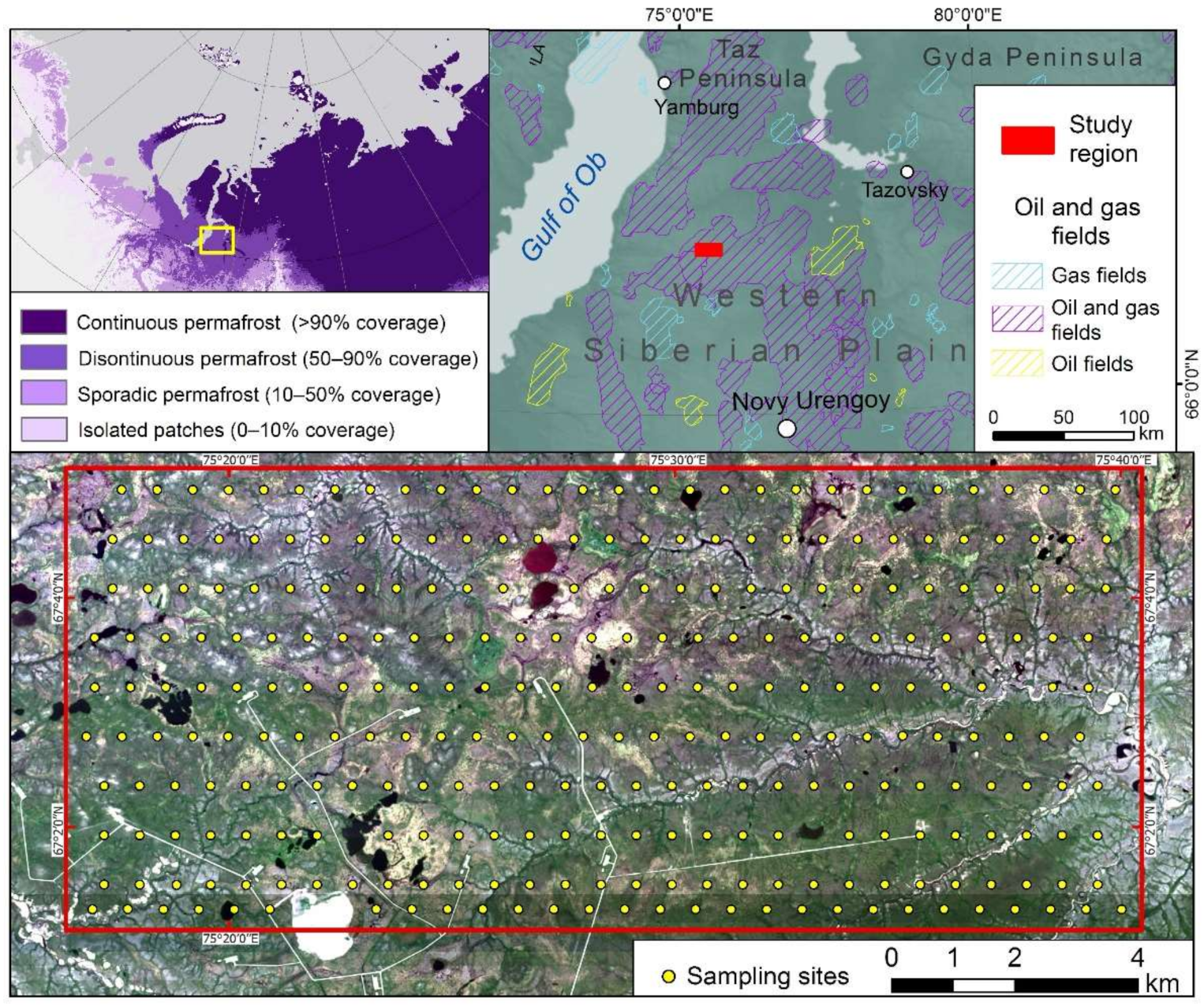

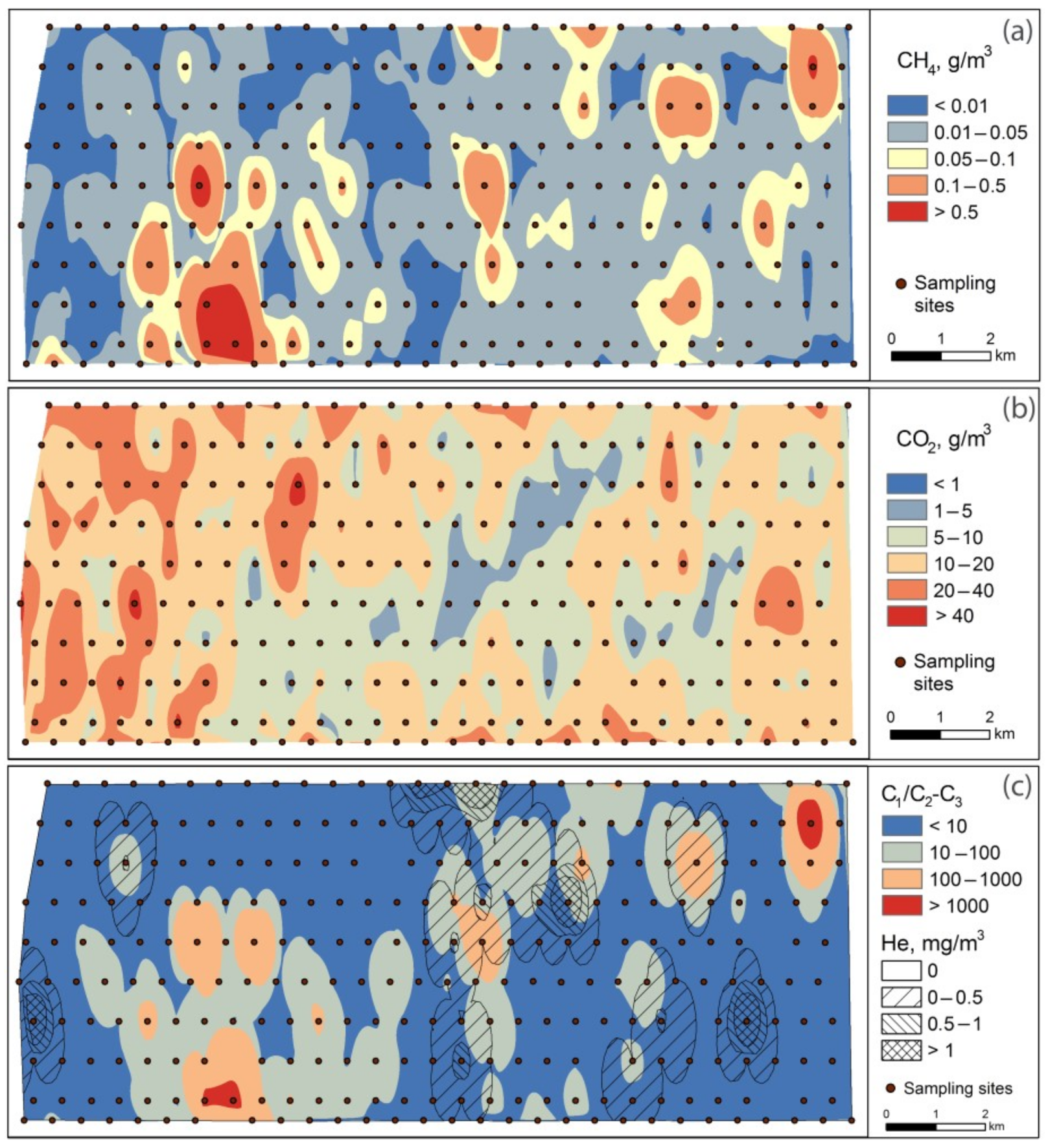
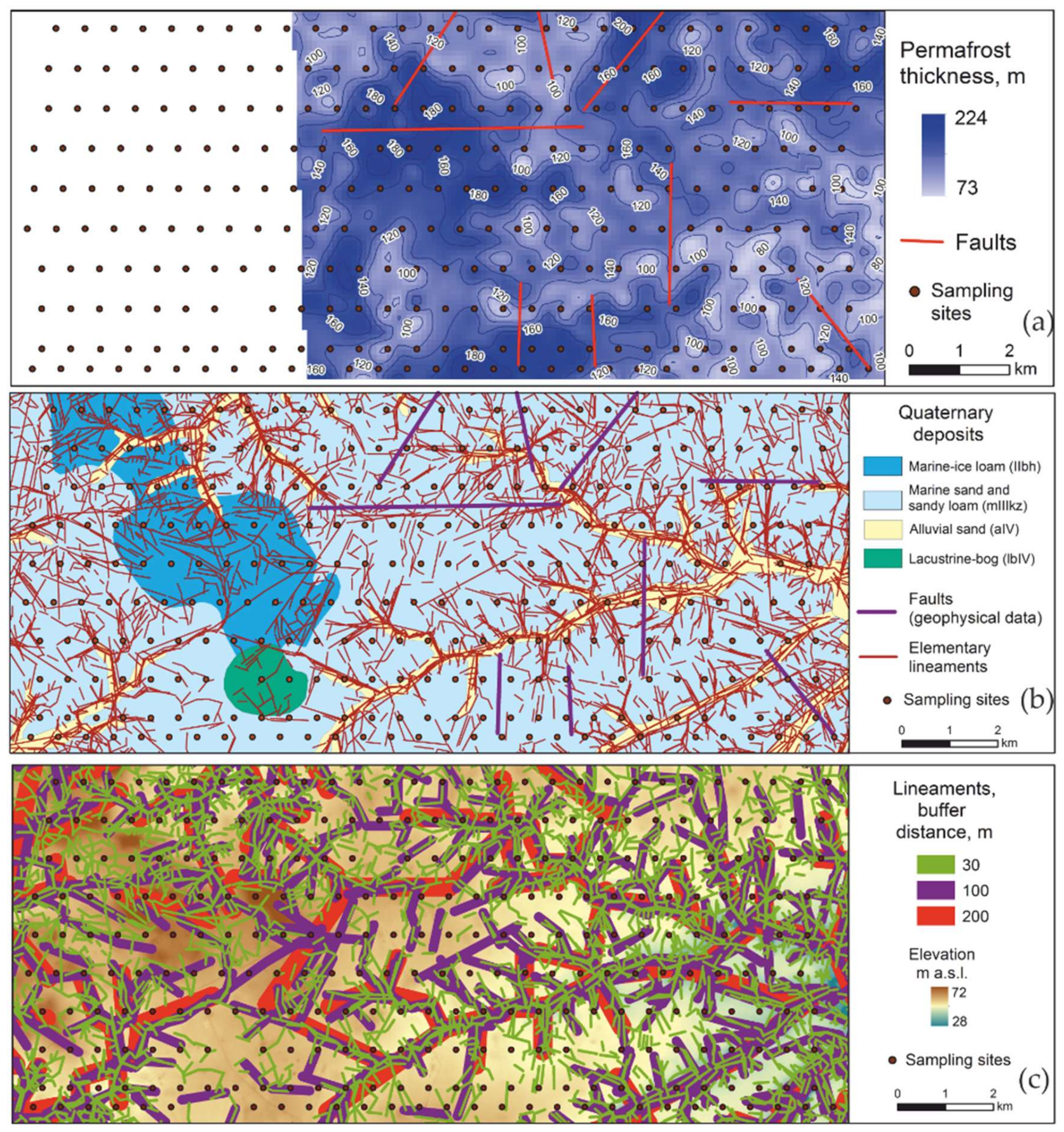
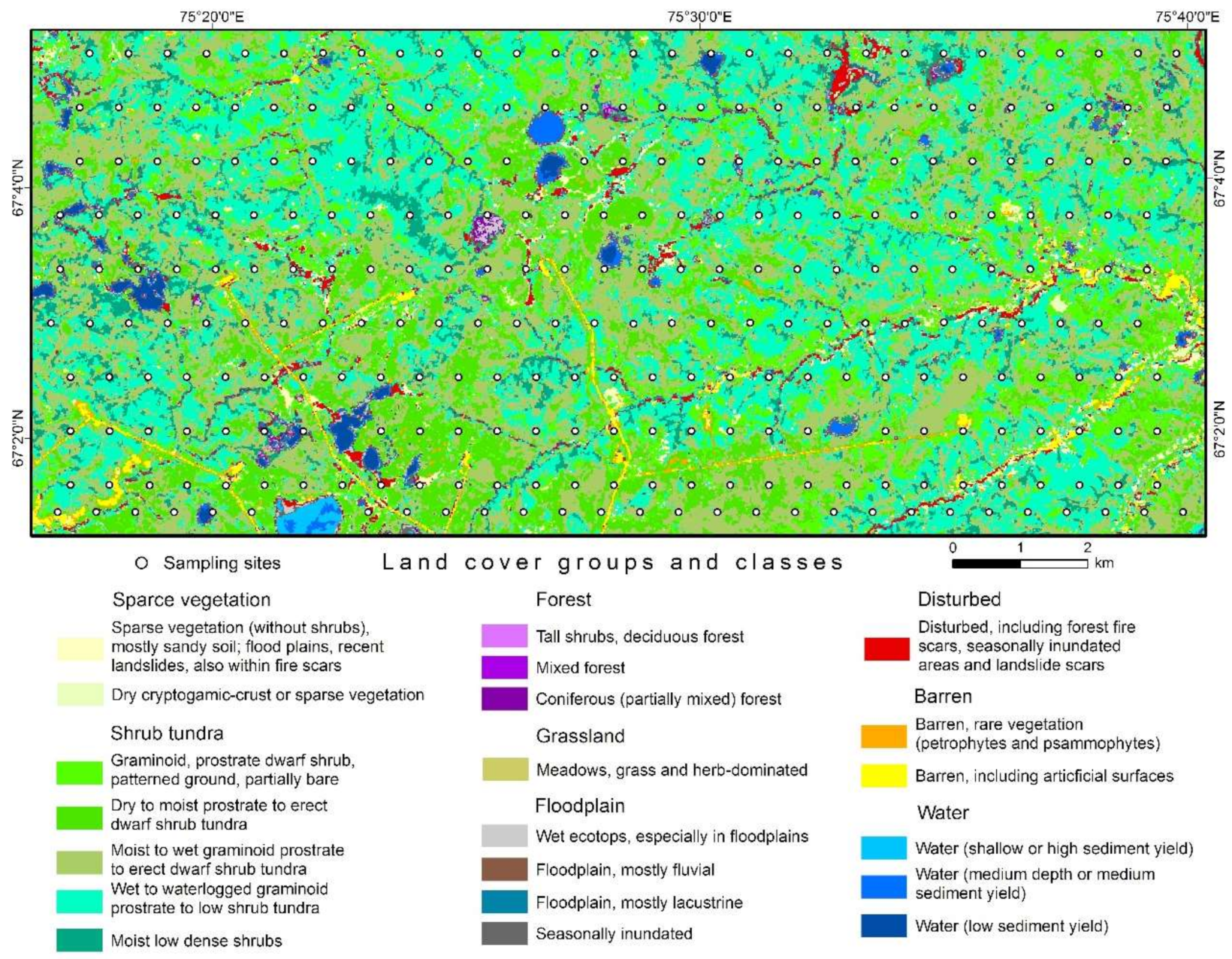
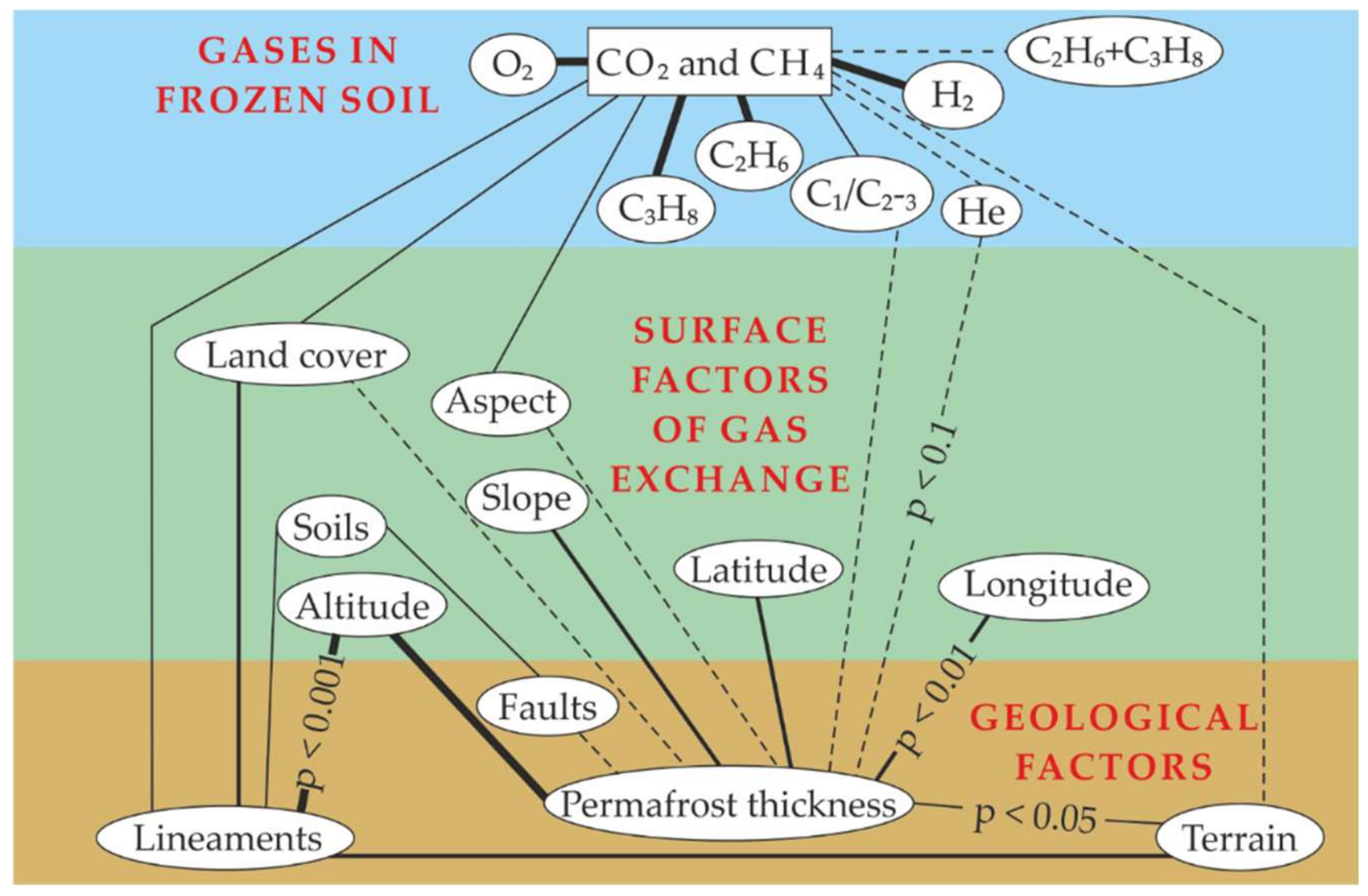

| Spatial Unit | CO2, g m−3 | CH4, g m−3 | n | Area, 106 m2 | Total Storage ** of CO2, 106 g | Total Storage ** of CH4, 106 g |
|---|---|---|---|---|---|---|
| 6.51 (3.42–11.16) | 0.04 (0.02–0.08) | 4 | 3.39 | 2.21 (1.16–3.78) | 0.01 (0.01–0.03) |
| 11.10 (5.81–19.09) | 0.01 (0.00–0.05) | 34 | 14.98 | 16.64 (8.71–28.60) | 0.02 (0.01–0.08) |
| 9.65 (4.13–18.99) | 0.01 (0.00–0.06) | 35 | 16.74 | 16.16 (6.91–31.79) | 0.03 (0.01–0.10) |
| 11.33 (4.24–24.17) | 0.02 (0.01–0.08) | 88 | 41.48 | 47.00 (17.60–100.26) | 0.08 (0.02–0.34) |
| 11.75 (5.37–22.15) | 0.01 (0.00–0.05) | 79 | 36.29 | 42.65 (19.49–80.39) | 0.05 (0.02–0.17) |
| 15.86 (7.18–30.07) | 0.01 (0.00–0.04) | 25 | 8.69 | 13.78 (6.24–26.14) | 0.01 (0.00–0.03) |
| 28.29 (19.15–40.10) | 0.06 (0.01–0.83) | 2 * | 0.07 | 0.21 (0.14–0.30) | <0.01 (0–0.01) |
| 8.15 | <0.01 | 1 | 0.34 | 0.28 | <0.01 |
| 13.32 (8.38–19.99) | 0.13 (0.04–0.51) | 5 | 2.55 | 3.39 (2.14–5.09) | 0.03 (0.01–0.13) |
| 8.70 (1.40–28.16) | 0.02 (0.01–0.04) | 3 | 0.88 | 0.77 (0.12–2.48) | <0.01 (0.00–0.00) |
| 4.40 | <0.01 | 1 | 0.57 | 0.25 | < 0.01 |
| 19.40 | <0.01 | 1 | 0.67 | 1.30 | < 0.01 |
| 7.47 (5.40–10.05) | 0.02 (0.00–0.11) | 3 | 2.22 | 1.66 (1.20–2.23) | <0.01 (0.00–0.03) |
| 6.48 (6.01–6.97) | <0.01 (<0.01) | 2 * | 1.83 | 1.19 (1.10–1.28) | <0.01 (0.00–0.00) |
| Total based on landscapes | 130.70 | 147.48 (64.80–282.34) | 0.24 (0.08–0.90) | |||
| Bakhta watersheds | 15.00 (7.21–27.32) | 0.01 (0.01–0.04) | 27 | 14.83 | 22.24 (10.69–40.51) | 0.02 (0.01–0.06) |
| Kazantsevo plain | 11.38 (4.88–22.35) | 0.02 (0.01–0.06) | 213 | 99.81 | 113.57 (48.67–223.09) | 0.15 (0.05–0.56) |
| Alases | 10.09 (4.00–20.80) | 0.02 (0.01–0.14) | 41 | 1.98 | 1.99 (0.79–4.11) | 0.01 (0.00–0.03) |
| Floodplains and bottoms of streams and gullies | 5.99 (5.08–7.01) | <0.01 (0.00–0.05) | 2 * | 14.20 | 0.97 (8.25–11.40) | 0.01 (0.00–0.08) |
| Total based on morphology | 130.80 | 146.31 (70.11–274.91) | 0.18 (0.06–0.73) | |||
| Total study area | 11.44 (4.89–22.51) | 0.02 (0.00–0.06) | 130.75 | 149.58 (63.94–294.32) | 0.26 (0.06–0.81) |
| Source Type | Total Storage on 130 km2, 106 g CH4 | Area Affected, % | Estimation Method |
|---|---|---|---|
| Faults | 0.126 | 63 | Equation (1) around lineaments |
| Microseeps | 0.003 | 5 | 0.005 g CH4 m−3 in the soils of He anomalies |
| Diffuse flow | 0.017 | 26 | 0.005 g CH4 m−3 in the soils outside lineaments, alases, and microseeps |
| TOTAL | 0.146 |
Publisher’s Note: MDPI stays neutral with regard to jurisdictional claims in published maps and institutional affiliations. |
© 2022 by the authors. Licensee MDPI, Basel, Switzerland. This article is an open access article distributed under the terms and conditions of the Creative Commons Attribution (CC BY) license (https://creativecommons.org/licenses/by/4.0/).
Share and Cite
Kraev, G.; Belonosov, A.; Veremeeva, A.; Grabovskii, V.; Sheshukov, S.; Shelokhov, I.; Smirnov, A. Fluid Migration through Permafrost and the Pool of Greenhouse Gases in Frozen Soils of an Oil and Gas Field. Remote Sens. 2022, 14, 3662. https://doi.org/10.3390/rs14153662
Kraev G, Belonosov A, Veremeeva A, Grabovskii V, Sheshukov S, Shelokhov I, Smirnov A. Fluid Migration through Permafrost and the Pool of Greenhouse Gases in Frozen Soils of an Oil and Gas Field. Remote Sensing. 2022; 14(15):3662. https://doi.org/10.3390/rs14153662
Chicago/Turabian StyleKraev, Gleb, Andrei Belonosov, Alexandra Veremeeva, Vasilii Grabovskii, Sergei Sheshukov, Ivan Shelokhov, and Alexander Smirnov. 2022. "Fluid Migration through Permafrost and the Pool of Greenhouse Gases in Frozen Soils of an Oil and Gas Field" Remote Sensing 14, no. 15: 3662. https://doi.org/10.3390/rs14153662
APA StyleKraev, G., Belonosov, A., Veremeeva, A., Grabovskii, V., Sheshukov, S., Shelokhov, I., & Smirnov, A. (2022). Fluid Migration through Permafrost and the Pool of Greenhouse Gases in Frozen Soils of an Oil and Gas Field. Remote Sensing, 14(15), 3662. https://doi.org/10.3390/rs14153662







